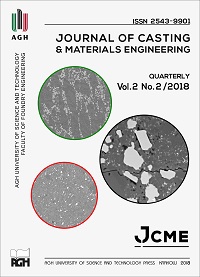Measurement of Molding Sand Elasticity
DOI:
https://doi.org/10.7494/jcme.2018.2.2.38Abstract
The progressive mechanization and automation of industrial equipment is the driving force of progress, not only in the field ofproduction but also in the measuring and control equipment. In mold production, the automation of processes such as forming
molds and cores along with their assembly has led to increases in serial production, reductions in defects, and the shortening
of molding times, among others. Thanks to automation in mold and core departments and the use of all sorts of manipulators,
mold production in foundries has gained momentum.
Unfortunately, in addition to the mentioned advantages, there are also new challenges as to the quality and properties of the
molding and core sands used in highly automated foundries.This article presents recent research on molding sand elasticity.
The topic was introduced as an attempt to answer the new needs of highly mechanized foundries.
The article discusses a new method of measuring the resistance of molding materials to undergoing mechanical deformation
(molding sand elasticity), with an additional analysis of the bending strengths of the tested samples. Precise measurements,
test sample preparation, and interpretation of the received results are presented in the article.
Downloads
References
Gröning P., Schreckenberg S. & Jenrich K. (2015). Herstellung von hochkomplexen Zylinderkurbelgehäusen ( part 1). GIESSEREI, 102(01), 42–47.
Gröning P., Schreckenberg S. & Jenrich K. (2015). Herstellung von hochkomplexen Zylinderkurbelgehäusen ( part 2). GIESSEREI, 102(01), 48–53.
Gröning P. & Serghini A. (2012). New cold-box systems and additives for serial production of castings. III Conference „Moulding and core materials – theory and practice”, 20–22 May. Zakopane, Hüttenes-Albertus Poland.
Stauder B.J., Kerber H. & Schumacher P. (2016). Foundry sand core property assessment by 3-point bending test evaluation. Journal of Materials Processing Technology, 237, 188–196.
Galina H. (1998). Fizykochemia polimerów, Rzeszów: Politechnika Rzeszowska.
Przygocki W. (2001). Fizyka polimerów. Warsaw: Polskie Wydawnictwo Naukowe.
Sperling L.H. (1992). Introduction to physical polymer science. New York: Wiley & Sons.
Riande E., Díaz-Calleja R., Prolongo M.G., Masegosa R.M. & Salom K. (1999). Polymer Viscoelasticity: Stress and Strain in Practice. New York: CRC Press.
Zych J. (2013). Bench Life (Work Time) of Moulding and Core Sands with Chemical Binders – a New, Ultrasound Investigation Method. Archives of Foundry Engineering, 13(4), 117–122. DOI 10.2478/afe-2013-0094.
Zych J. (2007). Behaviour of moulding sands with hydrophilic binders in dry air. Archives of Foundry Engineering, 7(4), 189–192.
Głuch S. (2016). The influence of hardening parameters on deformation of cores during resistance measurement on chosen moulding sands in cold-box technology. Engineering thesis. Kraków: Akademia Górniczo-Hutnicza.
Hutera B., Lewandowski J.L. & Smyksy K. (1999). Wpływ temperatury na właściwości wybranych mas formierskich Archives of Foundry Engineering, 6(20), 71–76.
Grabarczyk A., Dobosz S.M., Major-Gabryś K., Jakubski J. & Morek J. (2015). Elastyczność – nowe kryterium oceny jakości mas formierskich. Archives of Foundry Engineering, 15(4), 39–42.
Lewandowski J.L. (1997). Tworzywa na formy odlewnicze. Kraków: Wydawnictwo AKAPIT.
Morgan D. & Fashman E.W. (1975). The BCIRA Hot Distortion Tester for Quality in Production of Chemically Bonded Sands. AFS Transaction, 91, 73–80.
Ramrattan S., Vellanki S., Jideaku I. & Huang C. (1997). Thermal Distortion in Process Control of Chemically-Bonded Sands. AFS Transaction, 125, 161–165.
Rodriguez J., Keil M., Ramrattan S. & Krysiak M.B. (1989). Industry and Academia Collaboration for a Thermal Distortion Tester for Sand-Binder Systems. 1998 Annual Conference, 28 June 1989, Seattle, Washington, USA.
Ignaszak Z. & Popielarski P. (2009). Heat Transfer During Hot Distortion Test of Ceramic Porous Material Bonded by Various Resins. Defect and Diffusion Forum, 283–286, 382–387.
Ignaszak Z. (2008). Chosen aspects of thermo-mechanical phenomena in resin bonded sands by use of Hot Distortion tests. Archives of Foundry Engineering, 8(1), 137–142.
Giese S.R., Roorda S.C. & Patterson M.A. (2009). Thermal Analysis of Phenolic Urethane Binder and Correlated Properties. AFS Transactions, 102, 355–366.
Grabarczyk A., Dobosz S.M., Kusiński J. & Major-Gabryś K. (2018). The tendency of moulding sands to generate core cracks. Archives of Foundry Engineering, 18(1), 157–161.
Hutera B. (2004). Wpływ wybranych parametrów fizykochemicznych na wytrzymałość mas formierskich . Archiwum Technologii Maszyn i Automatyzacji, 24(1), 115–122.
Löchte K. (1998). Working with the Cold Box Process in the Coremaking Department of a Foundry. Hüttenes-Albertus Chemische Werke GmbH, July 1998, 1–21.
Baliński A. (2017). Effect of the way of modification of hydrated sodium silicate on the effectiveness of the changes in the residual strength of a moulding sand. Transactions of Foundry Research Institute 57(3), 161–168.
Psimenos A.Ch. (2008). Core and molding production with no-bake binder systems. Giesserei Praxis, 4, 111–119.
Dobosz S.M., Grabarczyk A., Major-Gabryś K. & Bolibruchova D. (2017). Elasticity of cores manufactured in cold box technology. Archives of Metallurgy and Materials, 62(1), 351–354.
Dobosz S. M., Grabarczyk A., Major-Gabryś K. & Morek J. (2016). Quality assessment of the moulding mixtures from the elasticity point of view. Technológ, 8(2), 19–23.
Major-Gabryś K. (2015). Biodegradable materials as binders for IVth generation moulding sands. China Foundry, 12(5), 375–381.
Huang R., Gao H., Tang Y. & Liu Q. (2011). Curing mechanism of furan resin modified with different agents and their thermal strength. China Foundry, 8(2), 161–165.
Mullier M.A., Seville J.P.K. & Adams M.J. (1987). A fracture mechanics approach to the breakage of particle agglomerates. Chemical Engineering Science, 42(4), 667–677.
Subero J. & Ghadiri M. (2001). Breakage patterns of agglomerates. Powder Technology, 120(3), 232–243.
Dobosz S.M. (1990). Aktywacja ciaplna piasków kwarcowych . Kraków: Wydawnictwo AGH.
Dobosz S.M. (2006). Woda w masach formierskic. . Rozprawa habilitacyjna. Zeszyty Naukowe AGH “Metalurgia i Odlewnictwo” (134). Kraków
Huteness-Albertus Polska (producers catalouge).
PrecOdlew - producers website. Retrieved January 24, 2018, from http://odlew.com.pl/zywice-i-utwardzacze-odlewnicze
Downloads
Published
Issue
Section
How to Cite
Accepted 2018-04-27
Published 2018-06-26


